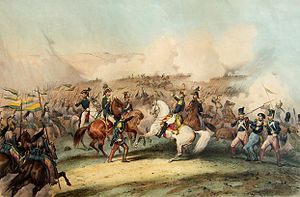Battle of Ingavi: Difference between revisions
no. it isnt part of |
Rescuing 3 sources and tagging 0 as dead. #IABot (v1.2.6) |
||
| Line 20: | Line 20: | ||
==History== |
==History== |
||
With the dissolution of the [[Peru-Bolivian Confederation]], the President of Peru, [[Agustín Gamarra]], made the controversial decision to invade Bolivia, utilizing the political chaos occurring in the Bolivian government as an excuse.<ref>[http://www.bandaancha.com.bo/e_bio_part.php?id=5 Biografías de Bolivianos Célebres]</ref> Gamarra, from the beginning, supported a union between Peru and Bolivia, but preferred it to be completely dominated by the Peruvian government, rather than to form a confederation between the two nations. |
With the dissolution of the [[Peru-Bolivian Confederation]], the President of Peru, [[Agustín Gamarra]], made the controversial decision to invade Bolivia, utilizing the political chaos occurring in the Bolivian government as an excuse.<ref>[http://www.bandaancha.com.bo/e_bio_part.php?id=5 Biografías de Bolivianos Célebres] {{wayback|url=http://www.bandaancha.com.bo/e_bio_part.php?id=5 |date=20070926234557 }}</ref> Gamarra, from the beginning, supported a union between Peru and Bolivia, but preferred it to be completely dominated by the Peruvian government, rather than to form a confederation between the two nations. |
||
Immediately, [[Jose Ballivian]] assumed power in the chaotic state of Bolivia, and proclaimed himself President. During this period there were three different governments attempting to rule Bolivia; a legitimate government headquartered in [[Sucre|Chuquisaca]] headed by [[José Mariano Serrano]], another headquartered in [[Cochabamba]] headed by [[José Miguel de Velasco]], and that of Ballivian headquartered in [[La Paz]]. |
Immediately, [[Jose Ballivian]] assumed power in the chaotic state of Bolivia, and proclaimed himself President. During this period there were three different governments attempting to rule Bolivia; a legitimate government headquartered in [[Sucre|Chuquisaca]] headed by [[José Mariano Serrano]], another headquartered in [[Cochabamba]] headed by [[José Miguel de Velasco]], and that of Ballivian headquartered in [[La Paz]]. |
||
| Line 33: | Line 33: | ||
==External links== |
==External links== |
||
* [http://www.boliviaweb.com/mar/capitulo3.htm Estados Unidos y el mar boliviano] |
* [https://web.archive.org/web/20080327120423/http://www.boliviaweb.com:80/mar/capitulo3.htm Estados Unidos y el mar boliviano] |
||
* [http://www.bolivia.com/noticias/AutoNoticias/DetalleNoticia17182.asp La Batalla de Ingavi] |
* [http://www.bolivia.com/noticias/AutoNoticias/DetalleNoticia17182.asp La Batalla de Ingavi] |
||
* [http://www.peru.com/elecciones2001/historia/elecciones_presidenciales/la_confederacion.asp Elecciones Perú 2001 - La Confederación Peruano-Boliviana] |
* [https://web.archive.org/web/20080311124632/http://www.peru.com:80/elecciones2001/historia/elecciones_presidenciales/la_confederacion.asp Elecciones Perú 2001 - La Confederación Peruano-Boliviana] |
||
* [http://sisbib.unmsm.edu.pe/BibVirtual/libros/Historia/Iniciacion_Republica/tomo2/Lib2_Cap7_5.htm Iniciación de la República Peruana] |
* [http://sisbib.unmsm.edu.pe/BibVirtual/libros/Historia/Iniciacion_Republica/tomo2/Lib2_Cap7_5.htm Iniciación de la República Peruana] |
||
Revision as of 17:17, 28 October 2016
| Battle of Ingavi | |||||||
|---|---|---|---|---|---|---|---|
| Part of Peru-Bolivian War | |||||||
 Battle of Ingavi | |||||||
| |||||||
| Belligerents | |||||||
|
|
| ||||||
| Commanders and leaders | |||||||
| Agustín Gamarra † | José Ballivián | ||||||
| Strength | |||||||
| Peruvian Army 5,199 | Bolivian Army 3,788 | ||||||
| Casualties and losses | |||||||
| Estimated 180 killed | Estimated 164 killed | ||||||
The Battle of Ingavi occurred on November 18, 1841, in the town of Ingavi, Bolivia. There the Bolivian Army commanded by Jose Ballivian met an invading Peruvian Army commanded by Agustín Gamarra who would later die during the battle.
History
With the dissolution of the Peru-Bolivian Confederation, the President of Peru, Agustín Gamarra, made the controversial decision to invade Bolivia, utilizing the political chaos occurring in the Bolivian government as an excuse.[1] Gamarra, from the beginning, supported a union between Peru and Bolivia, but preferred it to be completely dominated by the Peruvian government, rather than to form a confederation between the two nations.
Immediately, Jose Ballivian assumed power in the chaotic state of Bolivia, and proclaimed himself President. During this period there were three different governments attempting to rule Bolivia; a legitimate government headquartered in Chuquisaca headed by José Mariano Serrano, another headquartered in Cochabamba headed by José Miguel de Velasco, and that of Ballivian headquartered in La Paz.
Faced with the danger of a Peruvian invasion, the three governments joined under Ballivian and readied their armies, which in Ingavi, repelled the Peruvians.
Result
On November 18, 1841, with Agustin Gamarra being dead, the Peruvian Army left Bolivia. The news generated chaos in Lima, where the vice-president, Manuel Menéndez struggled to maintain his authority. He was soon deposed, with Juan Crisóstomo Torrico assuming power, allowing order to return to the country. This would be the last attempt of Peru to try to assume control of Bolivia.
Notes
- ^ Biografías de Bolivianos Célebres Archived 2007-09-26 at the Wayback Machine
External links
- Estados Unidos y el mar boliviano
- La Batalla de Ingavi
- Elecciones Perú 2001 - La Confederación Peruano-Boliviana
- Iniciación de la República Peruana
